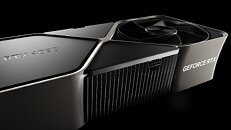- Joined
- Oct 9, 2007
- Messages
- 47,675 (7.43/day)
- Location
- Dublin, Ireland
| System Name | RBMK-1000 |
|---|---|
| Processor | AMD Ryzen 7 5700G |
| Motherboard | Gigabyte B550 AORUS Elite V2 |
| Cooling | DeepCool Gammax L240 V2 |
| Memory | 2x 16GB DDR4-3200 |
| Video Card(s) | Galax RTX 4070 Ti EX |
| Storage | Samsung 990 1TB |
| Display(s) | BenQ 1440p 60 Hz 27-inch |
| Case | Corsair Carbide 100R |
| Audio Device(s) | ASUS SupremeFX S1220A |
| Power Supply | Cooler Master MWE Gold 650W |
| Mouse | ASUS ROG Strix Impact |
| Keyboard | Gamdias Hermes E2 |
| Software | Windows 11 Pro |
NVIDIA's GeForce "Blackwell" generation of gaming GPUs will stick to being traditional monolithic die chips. The company will not build its next generation of chips as either disaggregated devices, or multi-chip modules. Kopite7kimi, a reliable source with NVIDIA leaks, says that the largest GPU in the generation, the "GB202," is based on a physically monolithic design. The GB202 is expected to power the flagship GeForce RTX 5090 (or RTX 4090 successor), and if NVIDIA sticking to traditional chip design for this, then it's unlikely that smaller GPUs will be any different.
In contrast, AMD started building disaggregated devices with its current RDNA 3 generation, with its top two chips, the "Navi 31" and "Navi 32," being disaggregated chips. An interesting rumor suggests that team red's RDNA 4 generation will see a transition from disaggregated chips to multi-chip modules—packages that contain multiple fully-integrated GPU dies. Back to the green camp, and NVIDIA is expected to use an advanced 4 nm-class node for its GeForce "Blackwell" GPUs.

View at TechPowerUp Main Site | Source
In contrast, AMD started building disaggregated devices with its current RDNA 3 generation, with its top two chips, the "Navi 31" and "Navi 32," being disaggregated chips. An interesting rumor suggests that team red's RDNA 4 generation will see a transition from disaggregated chips to multi-chip modules—packages that contain multiple fully-integrated GPU dies. Back to the green camp, and NVIDIA is expected to use an advanced 4 nm-class node for its GeForce "Blackwell" GPUs.

View at TechPowerUp Main Site | Source








 )
)